Lacey Louwagie's Blog, page 4
September 28, 2017
Fairy Tale Book Review: Kissing the Witch by Emma Donoghue
 Kissing the Witch: Old Tales in New Skins by Emma Donoghue
Kissing the Witch: Old Tales in New Skins by Emma Donoghue
My rating: 4 of 5 stars
So I guess I knew who Emma Donoghue was before she was “cool” (i.e., pre-ROOM), since this book has been on my shelf FOREVER … but I didn’t actually read it till after I’d read her more recent stuff. I’m generally 10-20 years behind on my TBR, though, so this is not at all unusual.
Having read her later stuff first, I can see that her writing voice is not quite as strong or refined in this collection, but the prose is still beautiful most of the time, with the exception of a few moments when it becomes vague or a little garbled. But as fairy tale retellings go, these are decent, not often changing the structure of the originals much, but casting their meaning in new light. In particular, I liked that the stories subverted the original trope common in fairy tales of women working against one another in competition, and instead presented heroines who were liberated by or in cooperation with the traditional “villains” in the story.
All of the retellings in this collection are connected, so the protagonist in one story is telling her tale to the protagonist of the previous tale. This forms a backwards running chain that I thought would somehow come full circle, but it didn’t. In some cases, the revelation of who a minor character in one story was in her past made perfect sense — in others, it felt like a stretch, and too bizarre to be meaningful (there are several instances of people being reincarnated as animals). Overall, this particular narrative device felt somewhat gimmicky, and I feel doubtful about whether Donoghue would have applied it later in her career as a more mature writer.
September 8, 2017
Abandoned Writing Book: The Author Training Manual by Nina Amir
 The Author Training Manual: Develop Marketable Ideas, Craft Books That Sell, Become the Author Publishers Want, and Self-Publish Effectively by Nina Amir
The Author Training Manual: Develop Marketable Ideas, Craft Books That Sell, Become the Author Publishers Want, and Self-Publish Effectively by Nina Amir
My rating: 2 of 5 stars
Officially creating a DNF shelf and adding this one to it.
After a two-year hiatus from this book, I have finally accepted what I knew long ago — I am not going back. And having it sit half-finished has held me back from pursuing other writing exercise books for far too long. It is time to move on.
I was initially excited about this book that tackles the more “business-y” side of writing and being an author, and I read and did the exercises diligently for the first several chapters. But the questions end up being incredibly repetitive and the exercises uninspiring, until my dread of returning to it led to the long break while I coped with the fact that this “finisher” was not going to finish this book.
I guess I’ll have to find some other way to train as an author.
July 31, 2017
How Early Motherhood Has Changed My Reading Life
Ten days ago, I became a mother when my son was lifted out of my abdomen behind a curtain, his cries filling the room and my heart welling up with relief. It was a long labor — 30 hours by the time he arrived — fraught with run-of-the-mill complications — meconium in the amniotic fluid, a labor that failed to progress leading to a multitude of interventions I hadn’t really wanted (but that I was grateful for in the end), and a baby that ultimately just wasn’t in the right position or of the right size to pass through the birth canal, despite the best efforts of my husband, myself, my doula and my baby to make it happen.

My son at two days old.
This is my first time writing anything at all since that day, although there has been so much to say — more to say than I can wrap my head around, and so little time in which to say it. As I write this, my son hangs off of me in a sling, sleeping in a diaper with his little chest puffing up and down. This is my first proof that I can find a way to make writing and motherhood compatible — I failed fairly miserably at writing throughout my pregnancy, when the best I could do was book reviews and journal entries a few times a week after I soldiered through a NaNoWriMo novel while feeling like I was going to puke at any and every moment in the first trimester.
When my husband and I had our final meeting with our doula before labor, she reminded us that at the end of pregnancy and during early parenthood, we would have to get used to doing things on a “small” scale. Smaller meals to ward off heartburn. Small naps when the discomforts of late pregnancy made it hard to sleep through the night, and when a newborn’s nursing schedule caused even more sleep disruption. Small breaks to connect with my husband, relax, watch a TV show or movie, play a game. I’ve noticed that my reading life has also become “smaller,” although these snatches of pages that I find time for here and there somehow seem more nourishing than they ever have before.
Nursing and a reluctance to wake a baby who has fallen asleep on my body often confines me to the same location for hours at a time. This means I read what is within reach, and my inability to be monogamous with books has reached a whole new level.
 At the rocking chair where I nurse my son, I have a copy of “The Blue Jay’s Dance: A Memoir of Early Motherhood” by Louis Erdrich that I read a page or two from when I can’t bear to look at my phone screen for another moment. My MP3 player is also within reach of that chair, so I listen to “Gregor the Overlander” for my book club, although I’m skeptical about whether I will finish it on time for our meeting on Thursday. Also, I listened to so much of the beginning section while sleep deprived in those first few days that I am playing catch up on who some of the major characters are. I always feel especially incompetent as a reader when I have trouble following a middle-grade novel — and no, this is not the first time that it’s happened, although I arguably have the best excuse now that I’ve ever had.
At the rocking chair where I nurse my son, I have a copy of “The Blue Jay’s Dance: A Memoir of Early Motherhood” by Louis Erdrich that I read a page or two from when I can’t bear to look at my phone screen for another moment. My MP3 player is also within reach of that chair, so I listen to “Gregor the Overlander” for my book club, although I’m skeptical about whether I will finish it on time for our meeting on Thursday. Also, I listened to so much of the beginning section while sleep deprived in those first few days that I am playing catch up on who some of the major characters are. I always feel especially incompetent as a reader when I have trouble following a middle-grade novel — and no, this is not the first time that it’s happened, although I arguably have the best excuse now that I’ve ever had.
In bed, I pull “The Womanly Art of Breastfeeding” down from the parenting reference bookshelf behind the bed and read it during those long 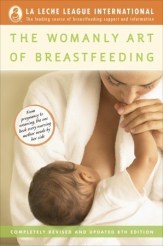 late-night feedings.
late-night feedings.
In the basement, where I used to do the majority of my “pleasure reading,” I read “How to Raise a Family on Less Than Two Incomes” while I wait for my husband to be ready to watch TV or play a game together. My time in the basement is limited — because of the C-section, I can only do one “stair trip” a day, and I stay down there only as long as my bladder holds out. Then the books and TV set and all the baby clothes and baby supplies on that floor are again out of my reach for the rest of the day.
I page through cookbooks at coffee shops while I wait for my husband to finish a political meeting. I listen to Aziz Ansari’s “Modern Romance” on the car’s CD system as I nurse my baby between any errands that take us away from home for more than two hours. I wonder whether my son recognizes Ansari’s voice from the time I spent listening while he was still inside the womb.
My progress through these books is very, very slow. When my son is awake and alert on my lap, I put them all aside so I can read to him from a couple board books that are also beside the rocking chair. There is a very good chance I will not meet my goal of reading 100 books this year, but I will continue to fill my eyes with words at any chance I get — and perhaps that more than anything keeps me feeling connected to the person I have always been as I make sense of the person I have been in the process of becoming ever since I saw that plus sign on a pregnancy test at the beginning of November.
May 24, 2017
Response to Goodreads Author Question – My Summer Reading List
What books are on your summer reading list this year?
Well … I’m expecting my first child in July, so my summer reading list is basically a crash course in parenting and domesticity. The stack consists of “Hypnobirthing” by Marie Mongan; “How to Raise a Family on Less Than Two Incomes” by Denise M. Topolnicki; “365 Ways to Live Cheap” by Trent Hamm; “The Womanly Art of Breastfeeding” by La Leche League; “The Nursing Mother’s Companion” by Kathleen Huggins; etc. A lot of these I’ll use for reference and probably not read cover-to-cover. I’m also hoping to finish “Women Who Run With the Wolves” by Clarissa Pinkola Estes (which I’ve been reading slowly over the last couple months) and hopefully throw in some graphic novels for a break. And the audiobooks I listen to always end up being the “wild card” in my reading life!
October 31, 2016
Tomorrow is Nov. 1. Enough Said.
Tonight is my last night of freedom, and I’m nursing a moderate migraine (yes, I get enough migraines to classify the severest of all headaches into severity classifications …) that interferes with my ability to either a) enjoy it, or b) frantically try to get all the things done that I won’t get done in November.
You can probably expect things to get pretty quiet around here.
Tomorrow it begins.
October 26, 2016
The Underside of Imagination in Panther
Yesterday I finished reading Panther by Brecht Evens.
It’s an artsy graphic novel that can be read in about an hour — a deceptively short amount of time, considering how impossible it is to shake once you’ve read it.
In my exploration of the book, I’m going to give spoilers, so if you want to read it unspoiled (it will only take an hour, after all!), you should come back to this post later.

Panther begins when Christine’s cat dies. She is heartbroken; this is not her first traumatic loss. Later in the book, we learn that her mother “left” the family and may have committed suicide. Christine is a sad, lonely little girl living in a big house with her father who seems to be basically a good guy, but I’ll come back to that later.
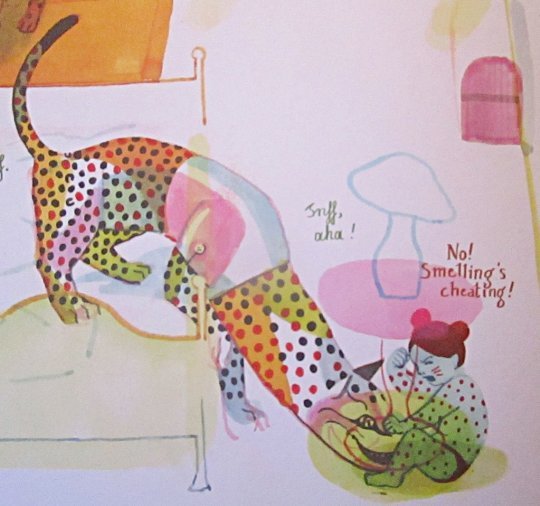 The night of her cat’s death, Panther emerges from Christine’s bottom drawer. He is shifty from the beginning, always changing his story and backtracking to make Christine happy. And she is mostly delighted with him. But the book’s sinister undertones are unsettling to the adult reader. In one image, Panther has his nose buried in Christine’s crotch, “sniffing” her out in a game of hide-and-seek. In another, he tells her she’s not “a little girl” anymore as he massages her back after trying to coax her to get the key to her room from her dad so she can have privacy. (This whole “key to the bedroom” thing kind of creeped me out all on its own. Why would you need a key to a child’s bedroom? Is she locked in at night?) Christine never discovers it, but Panther devours her stuffed dog, who had been attempting to warn her about him. When she notices the dog is gone, Panther replaces it with what basically an “evil twin” — a lookalike full of dangerous and unsettling suggestions for “games.” The night of Christine’s birthday party, the dog is the ringleader in a “game” that ends with the Pantherland gang stripping Christine down to her underwear while she cries and begs them to stop. Afterwards, Panther attempts to comfort her by urging her to snuggle up to him and “pet” him while he keeps her warm.
The night of her cat’s death, Panther emerges from Christine’s bottom drawer. He is shifty from the beginning, always changing his story and backtracking to make Christine happy. And she is mostly delighted with him. But the book’s sinister undertones are unsettling to the adult reader. In one image, Panther has his nose buried in Christine’s crotch, “sniffing” her out in a game of hide-and-seek. In another, he tells her she’s not “a little girl” anymore as he massages her back after trying to coax her to get the key to her room from her dad so she can have privacy. (This whole “key to the bedroom” thing kind of creeped me out all on its own. Why would you need a key to a child’s bedroom? Is she locked in at night?) Christine never discovers it, but Panther devours her stuffed dog, who had been attempting to warn her about him. When she notices the dog is gone, Panther replaces it with what basically an “evil twin” — a lookalike full of dangerous and unsettling suggestions for “games.” The night of Christine’s birthday party, the dog is the ringleader in a “game” that ends with the Pantherland gang stripping Christine down to her underwear while she cries and begs them to stop. Afterwards, Panther attempts to comfort her by urging her to snuggle up to him and “pet” him while he keeps her warm.
The book ends without “connecting the dots” of its troubling implications in any concrete way. What seems clear to me is that the book is grappling with the slippery connections between trauma, abuse, and imagination — but the lingering question is whether the potential creation/imagination of Panther was a coping mechanism for Christine to deal with real-life abuse, either past or present, or whether the entity of Panther itself was given too much power and ultimately became the abuser.

These are the possible interpretations that emerged for me upon first reading. (I had to return the book to the library, but I would not be surprised if additional meanings or interpretations emerged if I could spend more time with it.)
Panther represents a psychotic break. Since we are given hints that Christine’s mother may have killed herself, a family history of mental illness seems plausible. Panther and his creepy friends may indeed be “all in Christine’s head,” with schizophrenia being the tidiest explanation, but they are real to Christine because she has no conscious control over them.
Panther is an imaginary friend given too much power, and Christine creates trauma in her relationship with him as a way to banish him from her world.
 Panther is an imaginary friend that Christine creates to help her cope with or understand past or present abuse — most likely sexual abuse. Unable to understand the predation of a pedophile, Christine creates an actual predator to fill the abuser’s role. It could be that the trauma of her cat’s death awakened past traumas, or that the trauma is current and Christine is reinterpreting it as a coping mechanism. This is the interpretation I least want to be true, since the most likely candidate for current abuser is Christine’s father who, let’s not forget, is the only one with the key to her room. But I really want to believe she has someone safe in her life; if her father is also “Panther,” her outlook just feels far too hopeless.
Panther is an imaginary friend that Christine creates to help her cope with or understand past or present abuse — most likely sexual abuse. Unable to understand the predation of a pedophile, Christine creates an actual predator to fill the abuser’s role. It could be that the trauma of her cat’s death awakened past traumas, or that the trauma is current and Christine is reinterpreting it as a coping mechanism. This is the interpretation I least want to be true, since the most likely candidate for current abuser is Christine’s father who, let’s not forget, is the only one with the key to her room. But I really want to believe she has someone safe in her life; if her father is also “Panther,” her outlook just feels far too hopeless.Panther is a real being who is visiting Christine from another world, preying on her vulnerability and innocence. All the abuse that unfolds after is really Panther’s abuse — but because of the strange quality of it, Christine will never be believed if she discloses it. Panther and his friends are off the hook no matter what happens with Christine next.
I couldn’t help but think of Tulpamancy as I read the book — because Tulpas are “real” and “separate” people to their creators, I don’t think I am the only one who harbors an insidious fear of what might happen if a Tulpa “goes bad,” bringing its host with it. In fact, Panther could be read as a cautionary tale of just that sort.
But it could also be read as a demonstration of the only thing some people have to fall back on when their real life is too hard to bear: imagination. And no matter how scary that gets, it’s still a safer place than reality.
Regardless of interpretation, Panther is one of the most haunting explorations of that line between fantasy and reality that I have ever read.
October 17, 2016
Responsible Handling of Mental Health in YA Literature
Last weekend my husband and I attended NerdCon: Stories in Minneapolis. The first session I went to was titled “Mental Health in Young Adult Literature,” and it was presented by Amanda MacGregor with Teen Librarian Toolbox — a GREAT resource for those working in teen services or anyone who cares about YA lit. (This session made me miss my days as a teen services librarian so much.)
MacGregor talked a lot about how common mental illness is among teens (and the population in general — up to 25 percent of us will experience mental illness firsthand in our lives) and the importance of its presence in teen literature to show teens who have mental health struggles that they are not alone, and to foster greater compassion in those who don’t struggle personally. She stressed that it’s important that YA lit neither stigmatize nor romanticize mental illness, and that it show that help is possible. A work of fiction may be the first time a teen encounters someone who has a mind that works the same way as their own.
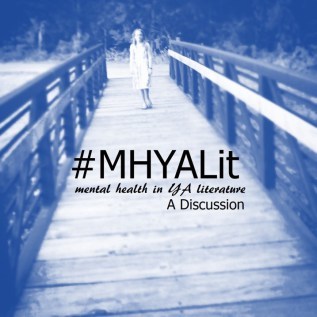 MacGregor shared her own lifelong struggle with anxiety, and she shared writing from YA authors who had written about mental illness, many of whom had personal experience with the mental health issues faced by their characters.
MacGregor shared her own lifelong struggle with anxiety, and she shared writing from YA authors who had written about mental illness, many of whom had personal experience with the mental health issues faced by their characters.
I agreed with MacGregor about the importance of portraying mental illness in a sensitive way when writing for young audiences, and I found myself examining my middle-grade novel through that lens.
Authors often talk about writing the book that they wished they’d had when they were young. I did the same, and much of what my protagonist, Maddy, goes through, I also experienced at her age. That includes my first brush with depression.
I struggled with depression throughout my adolescence, encountering it for the first time when I was about 10 years old — from there it would come and go in waves, hitting its apex when I was 16; I finally found relief when I was prescribed antidepressants to treat my chronic migraines.
My novel opens with Maddy’s suicide attempt; later in the book she experiments with self-harm. She is also the victim of bullying, to which, I would argue, depression is a natural response. She is never clinically diagnosed — I have never received a clinical diagnosis, either. She does encounter the concept of mental illness through her father, who falls into a depression after he loses his job. Because his depression interferes with his ability to contribute fully as a parent, Maddy’s mother pushes him to get help, and he does. So Maddy is aware that depression exists, and also that help exists for it. She even wonders briefly if she (and her mother) should get treatment. But she never sets foot in a therapist’s office, and she finds other ways to heal.
I have no doubt that adolescents struggling with mental illness fall through the cracks all the time. Part of it is that we just expect teenagers to be “moody” or “difficult.” As an adult or a parent, I’m sure it’s difficult to discern when a teenager’s struggles are a natural result of the seismic hormonal and social changes of that age, and when they signify an underlying chemical issue that should be professionally or medically treated. And often, teens themselves do not have the vocabulary to name what they are experiencing — or the agency to ask for help.
In light of MacGregor’s discussion, I find myself questioning whether it is irresponsible to portray mental illness without explicitly naming it in books aimed at children. Part of the challenge is that mental illness exists on a spectrum and is somewhat subjective, despite the existence of diagnostic questionnaires and the DSM-V. Although I, as the author, can diagnose depression in my main character, a reader could argue, based on the events of the story, that she has schizophrenia and/or dissociative identity disorder. I don’t agree with either of those diagnoses, but I certainly wouldn’t try to talk a reader out of that interpretation.
So the state of Maddy’s mental health, while described in some detail in the book, is never named. This wasn’t a decision I made consciously; and now that I have become more conscious of it, I’m resistant to changing it. Primarily this is because, unlike books such as Challenger Deep or Every Last Word, my novel is not ABOUT mental illness. Some of the characters in it are afflicted, just like some of the population is. Up until this point, I’ve always felt that what’s important is for young readers to recognize themselves in the feelings and experiences of a book’s protagonist — not necessarily that they have names for all those experiences.
But I’m having trouble thinking of similar books for young people that portray mental illness without explicitly naming it. It seems like characters in YA novels are either diagnosed with a named mental illness before or within the course of the story, or they are assumed to be mentally healthy. Does the genre have room for middle ground? And if it does, do you know of books that occupy that space?

October 10, 2016
Writing and “Tulpamancy”
At the end of August, Reply All ran a podcast episode called “Making Friends” that has been haunting me since I listened to it on a long drive a couple weeks ago.
The episode follows Shea, a 30-year-old woman who says she was about to commit suicide at age 16, when she heard a voice telling her to stop. She realized that the voice came from Jas, a character she had created for fan-fic she was writing. Over the years, she kept hearing Jas’s voice in her head, and says she essentially lived in two worlds: the real world, and the world she shared with Jas.
 One day, she stumbled upon a reddit forum for “Tulpas: Intelligent Companions Imagined Into Existence.” There, she discovered that other people also had these imaginary voices inside their heads. She became completely immersed in the “Tulpa” culture, creating more Tulpas and discussing Tulpa “techniques” with her new online friends. This included the idea of “fronting,” or letting your Tulpa take over your body/consciousness and live/speak through you. (Essentially, doing a character immersion exercise in which you let yourself live as your character for a while.) As she sank deeper and deeper into this world, Shea kept her new fascination secret from her husband, afraid that if she told him he would pressure her to go into therapy, that he would think she was crazy, etc. Eventually, the strain of keeping the secret ended up being too much for her. She told him, and within a year they were divorced.
One day, she stumbled upon a reddit forum for “Tulpas: Intelligent Companions Imagined Into Existence.” There, she discovered that other people also had these imaginary voices inside their heads. She became completely immersed in the “Tulpa” culture, creating more Tulpas and discussing Tulpa “techniques” with her new online friends. This included the idea of “fronting,” or letting your Tulpa take over your body/consciousness and live/speak through you. (Essentially, doing a character immersion exercise in which you let yourself live as your character for a while.) As she sank deeper and deeper into this world, Shea kept her new fascination secret from her husband, afraid that if she told him he would pressure her to go into therapy, that he would think she was crazy, etc. Eventually, the strain of keeping the secret ended up being too much for her. She told him, and within a year they were divorced.
He wrote a letter to the podcast explaining that, where he was concerned, Shea’s relationship with her Tulpa friends amounted to emotional infidelity, especially since two Tulpas who fall in love aren’t considered to be “cheating” even if their hosts are in committed relationships. And, one of Shea’s Tulpas had fallen for a friend’s Tulpa.
There are a few commonalities among most of those in the Tulpa community: they are often fans of science fiction and fantasy stories (check), they are often writers or other types of artists (check), and they often created their Tulpas in periods of isolation (check).
 I have never had an experience quite like Shea’s (mostly in that I have always kept my characters on a separate “level” and never allowed them to interact with me), but as a writer who has also lived a life alongside imaginary characters, her story stirred up a lot for me. I knew the feeling of living “two” lives — my own, and the lives of my characters. I knew the feeling of walking through my real life in a daze because I would rather be living the lives of people who didn’t exist. I also longed for a community where I could “come out” about my obsession with my own creations, although I did share them with my sister and a close friend.
I have never had an experience quite like Shea’s (mostly in that I have always kept my characters on a separate “level” and never allowed them to interact with me), but as a writer who has also lived a life alongside imaginary characters, her story stirred up a lot for me. I knew the feeling of living “two” lives — my own, and the lives of my characters. I knew the feeling of walking through my real life in a daze because I would rather be living the lives of people who didn’t exist. I also longed for a community where I could “come out” about my obsession with my own creations, although I did share them with my sister and a close friend.
But here’s where my story differs from Shea’s: whereas Shea has only delved more deeply into her imaginary relationships as she’s found that she’s not the only one, I have slowly left mine behind.
It’s one of the best decisions I ever made.
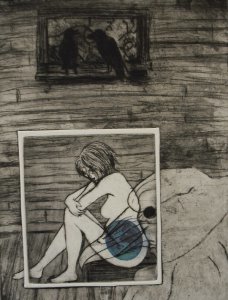
My sister’s artwork: http://mythoughtsaredeep.deviantart.com
I did not do it willingly. My hand was forced when one of the people I shared this world with told me that she was out. The relationships of my characters were so intertwined with hers that I wasn’t sure how to continue without her. I was devastated — I felt as though I was losing the best thing in my life.
But: I also felt a little bit relieved.
I had had a niggling feeling for years that what I was doing was not healthy. You would never know it on the outside. I had a successful career, I had authentic real-life friendships, I was living in a city I loved with my best friend and my two cats. I was learning to play guitar. I was writing novels.
While the imaginary world that existed alongside of this served as rich fuel for my writing — and, in fact, is still a vein I mine often — I also knew something else. Maintaining both lives was exhausting, and far too much of my emotional and mental energy was being swallowed up by characters who would never appreciate the late nights I spent advancing their stories or care that I thought of them a hundred times each day.
If I had known that the Tulpa community existed back then, I would have been relieved to let them catch me. I was looking frantically for something to fill the void. I tried online and computer role-playing games, continued writing from the perspective of my characters, explored puppetry. But none of it felt as real as what I had lost. If I had found outher “Tulpamancers” (those who create and live alongside imaginary beings), I know what would have happened. I would have delayed letting go, and let them assure me that I had finally found a place where I belonged and was truly understood. Rather than engage with the world around me, I would have pulled my own personal world more tightly closed.
I am so glad I did not find the Tulpa community.
When I made the decision to live fully within my own life, I felt raw and afraid and hopeful. I looked at everything with new eyes; without the filter of my imaginary characters, I remember thinking, “This is it. This is all I have.”
Sometimes, realizing that all you have left is your real life is the best way to make sure you live it.

It was not easy. I started seeing a therapist. I went through all the stages of grief — denial, anger, bargaining, and depression. I cried in my best friend’s arms late at night. I took sleeping pills to keep from staying up all night obsessing about the loss, and I confided to my boss that something had happened in my personal life that had shaken me and that I might be a little “off” for a while. I looked for any sign that someone else might have experienced a loss like this and found examples only in fiction. So I started seeking out books and movies that examined that boundary between reality and fantasy, and the power of the imagination to protect, heal, and imprison us. This became the subject of my middle-grade novel, which is about a 13-year-old girl summoning a Tulpa that she perceives as an angel, and her eventual realization that she has to let it go to make room for other good things, real good things, to come into her life.
That novel is my only book of fiction that is autobiographical, and when I told one of my friends that, she asked me how much of it had really happened, adding, “Besides the angel, of course.”
I thought, The angel is the most real thing about the whole book.
Of course, my character in the novel got her act together far more quickly than I did and did not drag it out into her twenties. In a book, that just would have been tedious.
As I began putting my life together around the loss, I became a more integrated person. I was no longer parceling my wants, desires, curiosities, and interests out among the many people who lived in my head. I was accepting them all as part of my own psyche, complicated and messy though it was. I made new friends, resented the presence of other people less, and invested in creating richer real-life connections. I lived through my pain — my real life pain — rather than run away from it. I cried in the shower, cried on the floor of my apartment, always going deeper but coming out feeling more whole on the other side.
I started dating.
Three years after my life changed, I met the man who would become my husband. I knew he was the one when I was able to tell him this story within months of meeting him.
I don’t think I ever would have allowed myself to love him if I hadn’t first let go.
When I talk to him about that time, he sees the richness of my imaginary world without any of the dysfunction. We listened to the podcast together, which brought up a lot of conversation about that time in my life. He wonders whether anything would ever bring me back there, and says he would be supportive if it was something I felt I needed to do for myself or for my writing. He promises he would help me find my way back to reality.
I told him that lots of people can drink socially and moderately without any trouble — but that an alcoholic can never again go near the stuff.
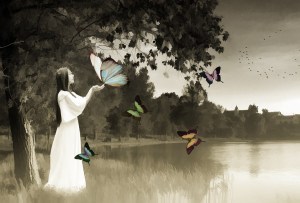 That is the kind of fear I have about ever sinking that deeply into an imaginary world again, and after some initial exploration, I’ve stayed away from role-playing games or anything else that blurs the line between reality and fantasy too much. I almost feel a sense of repulsion at the thought of trying anything like that again.
That is the kind of fear I have about ever sinking that deeply into an imaginary world again, and after some initial exploration, I’ve stayed away from role-playing games or anything else that blurs the line between reality and fantasy too much. I almost feel a sense of repulsion at the thought of trying anything like that again.
For most of my life, I feared that living too much in the real world would be a distraction from my writing, that it would ruin it. But living my life fully didn’t destroy my writing. In fact, living life fully is what writing is really about. I started having the kinds of experiences in real life that I had once only lived vicariously through my characters, and the melding of imagination and experience provided a deep well of inspiration. There are still times when I get lost in my imagination — it’s part of what makes the creation process exhilarating — but I no longer mentally “check out” of my real life for hours or days at a time. I put certain boundaries on my imagination so that when I’m living the rest of my life, I can truly be there.
But there is a lot about the Reply All episode that would resonate with almost any writer, regardless of whether their own characters have elevated themselves to the position of “Tulpa” within their lives. It’s fairly common for writers to claim their characters “talk to them” about what they want to happen in the story. And sinking deeply enough into a character to see the world through her eyes while writing is essentially the same as “fronting,” even if you do not show the world this other person’s existence until you are ready to share a draft.
 Writing this has been painful. But writing in general is painful. It requires sitting still and listening and drawing forth everything that’s inside of you and somehow creating everything that is not. The reason that it’s so difficult is because there is no one there to tell you how to do it, no magical creature from another realm to sit on your shoulder and guide you. It’s all you, all the time, and sometimes it’s scary to fully acknowledge and dredge up all that is bobbing around in our subconscious stew.
Writing this has been painful. But writing in general is painful. It requires sitting still and listening and drawing forth everything that’s inside of you and somehow creating everything that is not. The reason that it’s so difficult is because there is no one there to tell you how to do it, no magical creature from another realm to sit on your shoulder and guide you. It’s all you, all the time, and sometimes it’s scary to fully acknowledge and dredge up all that is bobbing around in our subconscious stew.
I now shy away from saying things like, “My character wouldn’t let this happen,” or “She just told me what she was going to do,” or “I just couldn’t get her to listen to me.”
It’s true that there is something less wild and frenzied about my writing when I no longer think about it in these terms, but it does not feel less real for being more disciplined. There is still something magical about creating and writing and discovering through fiction: but it is all the magic and wonder of what my own mind is capable of, the connections it draws while I’m not looking, and now I take full responsibility (and credit) for that.
The podcast had a “happy” ending — although Shea lost her marriage, she moved in with other Tulpamancers and no longer had to hide that part of herself. But the ending didn’t feel happy to me.
I don’t regret creating the world that I lived in for so long. It came into being at a time in my life that was so painful that “sleepwalking” through my reality really was the healthiest thing to do.
I think that is ultimately the role Tulpas need to play in our lives — they can take our hand to lead us out of the dark and the difficult parts of our lives, the parts that might breaks us if we allowed ourselves to stay fully present, times that might last days or weeks or months or years.
But when that period of darkness has passed, it’s time to thank them and let them go. Fix your gaze on them too intently, and you will never notice the moment the light begins to return.

October 3, 2016
Retelling Book Review: The Wrath and the Dawn by Renee Ahdieh
 The Wrath & the Dawn by Renee Ahdieh
The Wrath & the Dawn by Renee Ahdieh
My rating: 3 of 5 stars
This is a first novel, and it feels like one. The prose is overwritten and tends toward the purple, and it resorts to using the same descriptions far too often. Like, we don’t need to know that Jalid has “tiger eyes” each time he looks at Sherzhad, do we? Or that Sherzhad has luscious, waist-length hair? There also seemed to be something weird going on with transitions, because I often had to backtrack to figure out how we got from one scene to another, or from one point of view to another, etc.
It’s hard to redeem the caliph who murders a new bride every night, and this book puts forth a valiant effort. But in doing so, it sort of lets him off the hook for his crimes, which is a little off-putting. The tumultuous love story between Jalid and Sherzhad probably would have captured my interest if I read this as a teenager, but as an adult it felt a bit on the melodramatic side. Plus, whenever I started to get into it, there was, “Oh yeah, but this guy has killed a bunch of women,” and that sort of killed the mood for me.
The world-building is pretty shaky and doesn’t seem to be firmly rooted in Middle Eastern history or in a new, magical world. It ends up being a sort of mashup of the two, but the magic plays such a tangential part in the story that it feels a little out of place. There are curses and random powers inserted mostly for the sake of convenience and without feeling as though they are truly woven into the fabric of this time and place. And, like, why was there a magic carpet that never even did anything? I could have done without the half-baked love triangle, too.
I gave the book three stars, so obviously it wasn’t all bad. It held my interest well enough even if it annoyed me at times, and there are far too few retellings of fairy tales outside the European canon. It ends on a little bit of ambiguity/cliffhanger which seems to set it up for a sequel, in which the love triangle is destined to take center stage. I don’t think I will be reading it.
September 27, 2016
Interactive Fiction: Is it Real Literature?
 Last weekend was South Dakota’s annual Festival of Books, a free event that draws together authors and readers from across the state and beyond. There are always plenty of sessions that are of use to writers, and a bunch that are like crack to readers, and I always walk away from the festival feeling inspired to write more and read more, to step outside my comfort zone both in my writing life and my reading life. It’s a feeling of intellectual vibrancy that is one of my favorite feelings in the world.
Last weekend was South Dakota’s annual Festival of Books, a free event that draws together authors and readers from across the state and beyond. There are always plenty of sessions that are of use to writers, and a bunch that are like crack to readers, and I always walk away from the festival feeling inspired to write more and read more, to step outside my comfort zone both in my writing life and my reading life. It’s a feeling of intellectual vibrancy that is one of my favorite feelings in the world.
This year, the festival was taking place in a town an hour from where I live. I had an early-morning doctor’s appointment on Saturday, and I had slept poorly the night before. I mentioned to my husband that I was thinking of going back to bed rather than driving up for the festival.
“Don’t do that,” he said.
After my second session, I sent him a text to thank him for talking me out of the temptations of bed on a Saturday.
Although I usually attend anywhere from 5 to 9 sessions, there is always one that stands out. This year, it was Steven Wingate‘s* presentation on the “Digitization of Literature.”
I did not know what the session was going to be about, but I’m on board with the digital revolution (mostly), and I like literature, so I figured there was bound to be something useful there. Little did I know that I would leave that 45-minute talk with my mind bursting with new ideas.

Best Choose Your Own Adventure book EVER.
The session was mostly focused on “interactive fiction” — storytelling that draws the reader in as an active participant in the way the story unfolds. Think Choose Your Own Adventure for grownups. Some interactive fiction is similar to the Choose Your Own Adventure books of your childhood, where the reader is asked to choose between various paths. Others are more a labyrinth of text, images, videos, and other stimuli that draw you into a non-linear storytelling experience. Still others employ artificial intelligence for an almost limitless set of possibilities.
Although most of the examples Wingate covered were largely text-based and “light” on the coding side, he acknowledged that there is a very fine line between interactive fiction and “gaming.” I was noticing the same thing, and thinking about some of the games that I have been playing with my husband over the past few months. I don’t really identify with gaming culture, but my husband is a gamer. He’s made it something of a mission to find “story-rich” computer games that he thinks I’ll like, and that we can play together. He’s been right. So far, we’ve played Gone Home, The Stanley Parable, Among the Sleep, and Firewatch. With the exception of Stanley, which is more commentary than story, everything we’ve played has haunted me after the credits have begun rolling, just the way the best stories always do. These games don’t only allow the same “immersion” experience of a good book where it’s a treat to let the rest of the world fade away, but they go beyond mere plot to impart themes and messages to the player. All the games left me with questions at the end, and a sense that these people could have been real. Most games have at least a rudimentary plot, but not everything with a plot feels like literature. It’s the attention to character, to detail, and to an experience that lingers that sets these games apart. And the fact that you feel changed somehow by the experience when you walk away from it. 
Since my husband is a gamer and a software programmer and I am a writer, since our dating days we have played around with the idea of collaborating on a game. So far, the right impetus has not come along. But after seeing some examples of interactive fiction at the session, as well as discovering that there are programming engines like Twine out there to help you build your story, I feel as if it’s something I might actually be able to do. I am even considering writing an “interactive” novel for NaNoWriMo, which I usually use as an opportunity to try more “experimental” projects.
A few months ago, I listened to an episode of a Freakonomics podcast that referenced the old 10,000-hour rule, but went beyond it to stress that to truly master your art, you can’t just put in that time. You also have to deliberately stretch yourself to try new things. Immediately, I thought about my tendency to want to drift between genres and audiences when I write, and realized that this may not be a sign of a “scattered” sense of creativity or a short attention span, but a subconscious effort to improve my skill by venturing into new territory. With over ten novels under my belt, interactive fiction might just be the next step.
* Check out Steven Wingate’s interactive memoir, DaddyLabyrinth, or his interactive immigration experience, Talk With Your Hands Like an Ellis Island Mutt.




